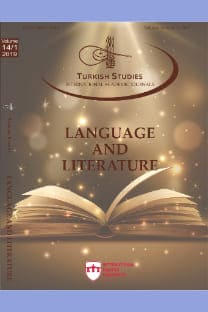Çeviriye Bakış Açısı Ölçeğini Türkçeye Uyarlama Çalışması*
Adaptation Study of The Inventory for Beliefs About Translation
___
- Çokluk, Ö., Şekercioğlu, G., & Büyüköztük, Ş. (2014), Sosyal Bilimler İçin Çok Değişkenli Istatistik SPSS ve LISREL Uygulamalar. Pegem Akademi.
- Danchev, A. (1983). The controversy over translation in foreign language teaching. Translation in the system of foreign languages training. Paris: Round Table FIT-UNESCO (pp. 35-43).
- Deniz. Z. K. (2007) The adaptation of psychological scales, Journal of Faculty of Educational Sciences, 40(1), 1-16, Ankara University. https://www.researchgate.net/publication/284460462_The_Adaptation_of_Psychological_S cales
- Divarcioğlu, D. (2020). Öğrenme stratejisi olarak çeviri ölçeğini Türkçeye uyarlama çalışması. Turkish Studies - Language, 15(4), 1773-1784. https://dx.doi.org/10.47845/TurkishStudies.46112
- Dural, S., Aslan, G., Alinçe, M. ve Araza, A. (2014). Örgütsel Çekicilik: Bir Ölçek Uyarlama Çalışması. Doğuş Üniversitesi Dergisi, 15 (2), 141-154.
- Hambleton, R. K., & Patsula, L. (1999). Increasing the validity of adapted tests: Myths to be avoided and guidelines for improving test adaptation practices. Journal of Applied Testing Technology, 1, 1-12.
- Horwitz, E. K., Horwitz, M., & Cope, J. A. (1991). Foreign language classroom anxiety. In E. Horwitz & D. Young (Eds.), Language anxiety: From theory and research to classroom implications (pp. 27-36).
- Kopczynski, A. (1983) “Verbal Intervention. Translation in Foreign Language Teaching“: in Translation in Foreign Language Teaching, Paris, Round Table FIT-UNESCO, pp. 58-59.
- Kupske, F. F. (2015). Second Language Pedagogy and Translation: The Role of Learners’ Ownlanguage and Explicit Instruction Revisited. Brazilian English Language Teaching, 6(1), 51–65. http://dx.doi.org/10.15448/2178-3640.2015.1.20201
- Liao, P. (2002). Taiwanese College Students’ Beliefs About Translation And Their Use Of Translation As A Strategy To Learn English. Dissertation, The University of Texas,
- Malmkjær, K. (Ed.). (1998). Translation & Language Teaching: Language teaching & translation.
- Mollaei, F., Taghinezhad, A. & Sadighi, F. (2017). Teachers and Learners’ Perceptions of Applying Translation as a Method, Strategy or Technique in an Iranian EFL Setting. International Journal of Education & Literacy Studies. 5(2), 67-73. http://dx.doi.org/10.7575/aiac.ijels.v.5n.2p.67
- Newmark, P. (1991). About translation. Clevedon.
- Newson, D. (1998). Translation and foreign language learning. In K. Malmkjær (Ed.), Translation & language teaching: Language teaching & translation (pp. 63-76).
- Önder, İ. ve Beşoluk, Ş. (2010). “Düzenlenmiş İki Faktörlü Çalışma Süreci Ölçeği’nin (R-SPQ-2F) Türkçeye Uyarlanması”. Eğitim ve Bilim, 35 (157), 55–67.
- Randaccio, M. (2012). Translation and Language Teaching: Translation as a useful teaching Resource. In: Gori, F. & Taylor, C. Aspetti del la didattica e del l’apprendimento del le lingue straniere: contribute de icollaboratori del Centro Linguistico del l’Università di Trieste (v. 2). Trieste: EUT Edizioni Università di Trieste, pp. 78-91.
- Sarıgül, H. (2015). Finansal okuryazarlik tutum ve davranis ölçegi: Geliştirme, geçerlik ve güvenirlik. Yönetim ve Ekonomi Araştırmaları Dergisi, 13(1), 200-218.
- Şencan, H. (2005). Sosyal ve davranışsal ölçmelerde güvenirlik ve geçerlik. https://www.ders.es/guvenilirlik_gecerlilik.pdf
- ISSN: 2667-5641
- Yayın Aralığı: 4
- Başlangıç: 2006
- Yayıncı: ASOS Eğitim Bilişim Danışmanlık Otomasyon Yayıncılık Reklam Sanayi ve Ticaret LTD ŞTİ
Eski Hastalık Romanında Yol ve Yolculuk Metaforu
Reşat Nuri’de İdealizm ve Tiyatronun Birleştiği Nokta: Son Sığınak
Two Inspirations by Sainte-Beuve and Tolstoy: Art and Canon
Zeynep BÜYÜKSARAÇ, Melek ALPAR, ERDOĞAN KARTAL
The Journey of Search in Reşat Nuri Güntekin's Novel Acımak
İkili Karşıtlıklar: Saatleri Ayarlama Enstitüsü’nde Ölümlerin Yeri
Bir Mektup Roman: Çirkinin Romanı/Bir Kadın Düşmanı
Shakespeare’in Hamlet ve Köksal’ın Sacide’sinde Kadın Tasviri ve Ataerkil Uygulamalar
Reşat Nuri Güntekin'in Yeşil Gece Adlı Romanında Kavram Alanı Üzerine Bir Deneme
Vehim, Kurban, Gerçeklik: Reşat Nuri Güntekin’in Damga Romanında Birey ve Toplumsal Algı
